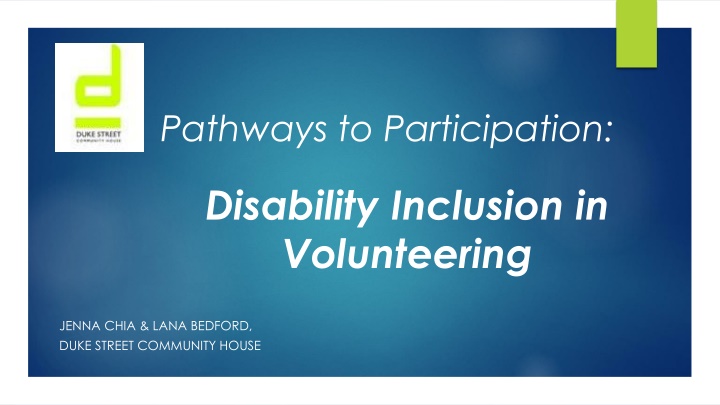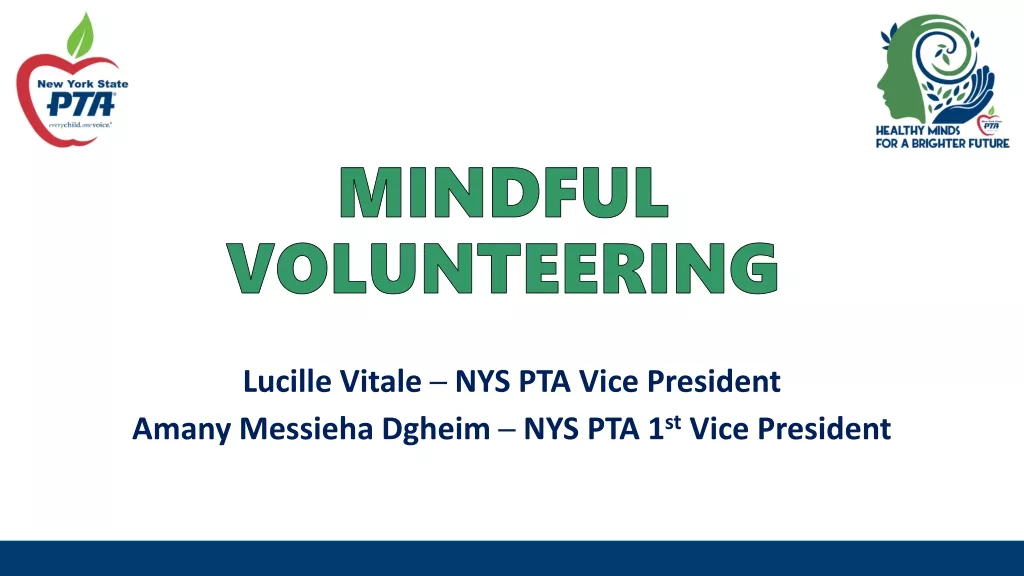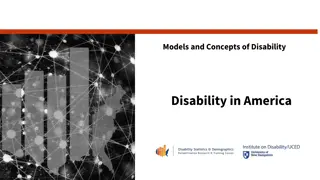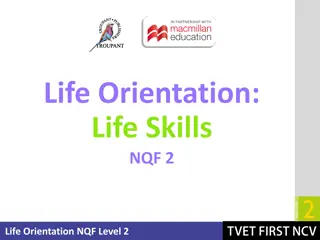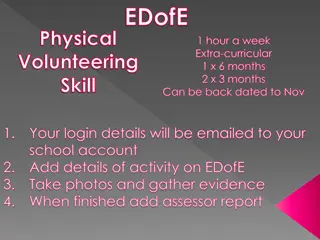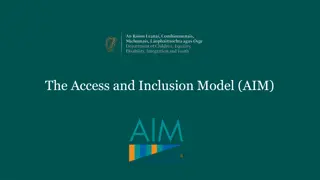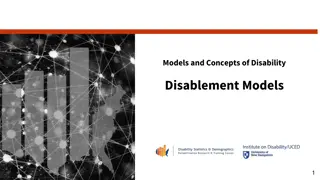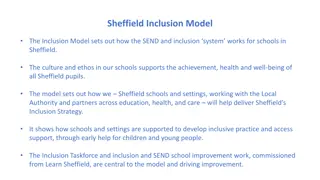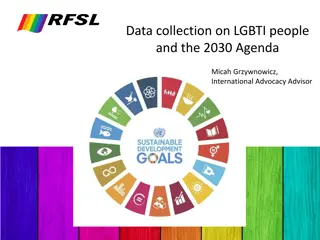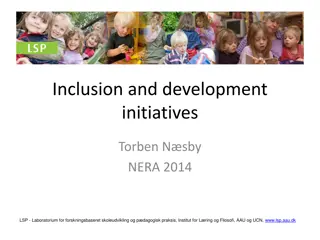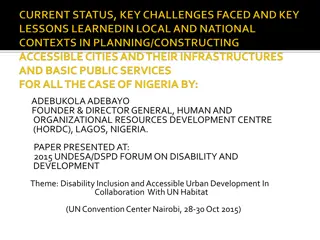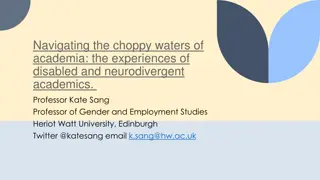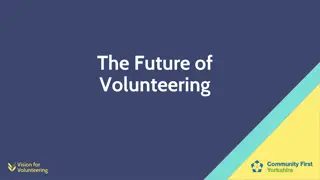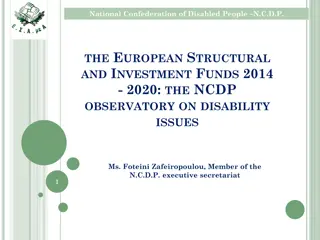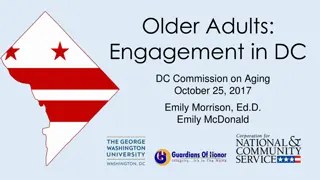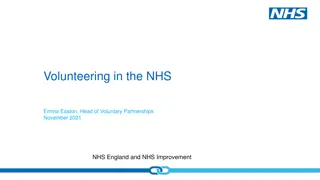Disability Inclusion in Volunteering Research
Content covers pathways to participation for individuals with disabilities in volunteering, project overview, theoretical approach, key research findings including skills and experiences of volunteers with disabilities, social connections, organizational factors, and benefits of disability inclusion.
Download Presentation

Please find below an Image/Link to download the presentation.
The content on the website is provided AS IS for your information and personal use only. It may not be sold, licensed, or shared on other websites without obtaining consent from the author.If you encounter any issues during the download, it is possible that the publisher has removed the file from their server.
You are allowed to download the files provided on this website for personal or commercial use, subject to the condition that they are used lawfully. All files are the property of their respective owners.
The content on the website is provided AS IS for your information and personal use only. It may not be sold, licensed, or shared on other websites without obtaining consent from the author.
E N D
Presentation Transcript
Pathways to Participation: Disability Inclusion in Volunteering JENNA CHIA & LANA BEDFORD, DUKE STREET COMMUNITY HOUSE
Context: The state of disability inclusion in volunteering 1 in 5 Australians live with disability People living with disability experience higher rates of social inequality across numerous measures Volunteering as an opportunity for community and social participation People living with disability experience barriers to volunteering
Pathways to Participation: Project Overview Local community research project funded by DHHS Brimbank/Melton Aims: To explore the issue of disability inclusion in volunteering in the local area of Brimbank City Council, an LGA in Western Metropolitan Melbourne from the perspective of: Community members living with disability Local volunteering involving organisations
Pathways to Participation: Project Overview Theoretical approach Social model of disability and Human Rights approach Integrated theory of volunteering Community-based and participatory principles Methods: Community engagement, interviews and surveys Participants Community members living with disability Volunteer-involving organisations (volunteer managers & coordinators)
Key research findings Finding 1: The experience and skills of volunteers with disability Finding 2: The relationship between social connections and volunteering Finding 3: The role of organizational factors in inclusive volunteering Finding 4: The benefits of disability inclusion in volunteering
1. The Experience and Skills of Volunteers with disability Extensive range of skills & experiences of volunteers living with disabilities The value of these skills to the community Highlights the need for: A focus on ability, strengths and contribution Flexible and innovative volunteering opportunities Clear employment pathways
I can tell you that the impression in the community and the reality is that volunteering doesn t always lead on to paid work. It s frustrating because people gain the skills and experience through volunteering but then can t get a job. It s different to what we re being told Community member
2. The role between social connections and volunteering Social connections lead to volunteering opportunities, and vice versa Social isolation and the role of community attitudes Highlights: The important role of families and services in promoting connection The need for increased opportunities for community engagement including volunteering Community education & addressing stigma & discrimination
Like the young ones, they can be very cruel too. They should have more understanding and they should be more educated about it in school. And then they'll be much nicer to us, they'll be more friendly to us, and treat us like humans. Because we are human! Community member
3. Organisational factors in Inclusive Volunteering Attitudes and behaviours of staff and volunteers Inclusive organisational policies and procedures Organisational feedback and support mechanisms Highlights the need for: A commitment to inclusion at every level of the organisation Individual reflection on workplace practice
Training is definitely a big one, if we didnt have that lady (staff member with disability experience) we wouldn t be able to understand, or have the help, to learn how to work with disability volunteers. My first impression with them was like ohdisability , I don t know, because of the stigma, you think of that disability,can t do anything , so you need to break that down. And having one member of the team with that experience and having training, was really good Organisational staff member
4. The Benefits of Disability Inclusion in Volunteering Organisational benefits: Addressing misconceptions & stigma Greater access to a pool of skills, knowledge & experience Understanding & representing diversity Community benefits: Wellbeing, confidence, meaningful activity Skills and experience Social connections
I actually wanted to go in there and everyone was so friendly. Like, you could walk into a room or into the office to get your name badge and people weren't looking over your shoulder. And just being with other people and, helping other people. And I actually started feeling better, myself, like emotionally and physically. -Community member
The project principles Community development + participatory principles = Steering committee; volunteer & disability sector, community members Consultations with community groups & stakeholders Commitment to provide regular feedback to community Community & networking events as part of dissemination strategy Leading to
Key project outcomes Opportunities for promotion of inclusive volunteering Improved organisational networks and connections Direct volunteer opportunities Increased organisational capacity
Summary: Enhance Diversity & inclusion = enhanced capacity of organisations and volunteer programs Community development principles = increased opportunities for communities and organisations
Summary: Connect Volunteering = social connections = volunteering Participatory approaches increased connections With the community Between organisations
Acknowledgements Project steering committee Genia Sawczyn (DHHS) The Brimbank community Lana Bedford (DSCH) Staff, students and committee of Duke Street Community House Lisa Frost (Brimbank Council) Christine Bell (Brimbank Council) Jason Heagerty (Community member) Volunteers! Jane Pearce (Mambourin) Dominic Szeker (Volunteering Victoria) Josie Marchione (WCIG) Scope, Volunteer West, Tipping Foundation
